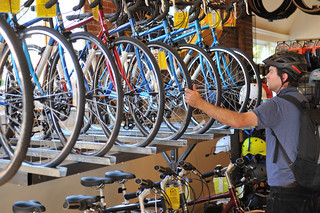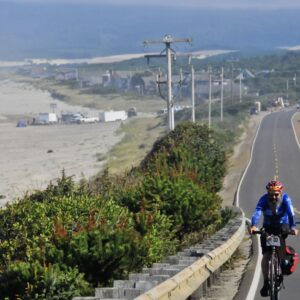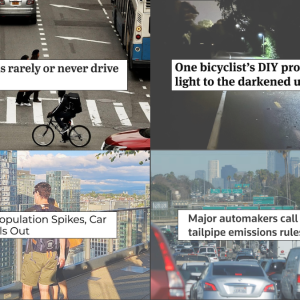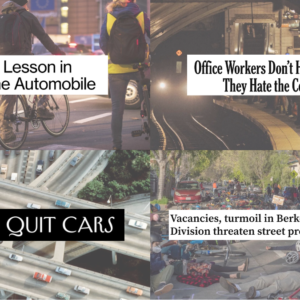It was the sort of dramatic headline that launches a thousand tweets: “In almost every European country, bikes are outselling cars.”
It was true, and it caught our attention. But it skipped a pretty important detail: new bikes have been outselling new cars in the United States for most of the last 20 years, and probably longer.
Wait, bikes outsell cars in the United States? But not, until recently, in Italy, where one in 10 workers nationwide commutes by bicycle? How could this possibly be true?
After reporting on “the return of high-volume U.S. bike frame manufacturing”, we decided to call someone who knows a lot about the subject: Fred Clements, executive director of the National Bicycle Dealers’ Association.
Clements didn’t believe the figures at first, either.
“Really?” he asked.
Really. Even if you include light trucks in the total (a personal vehicle category that represents 1 in 4 U.S. auto sales but doesn’t really exist in Europe), Americans bought 14.4 million new autos last year and 18.7 million new bikes.
Italians, meanwhile, bought 1.4 million new cars last year and 1.6 million new bikes, the first time since World War II that bikes beat cars.
But here’s the thing, said Clements, whose organization represents and serves hundreds of specialty bike shops nationwide: most American bikes sold (“99 percent” of which, he said, are imports) simply aren’t much fun to ride. They’re either heavy or fragile, and that’s part of the reason that thousands of them them are quickly left to rust in garages. It’s a completely different situation from Europe, where most new bikes tend to be “classic three-speeds — [they’re] heavy and they’re utilitarian, but they’re bomb-proof,” Clements said. “They’re not going to break or wear out.”
“A lot of the inexpensive low-end bikes here, they may be cheap but they’ve got a bright paint job,” he went on. “They function, but I think people have a hard time knowing the difference.”
Clements could have been describing my own experience. I rode bikes regularly since I was 10, but until I bought my first upright hybrid (used, for what I thought was an eye-popping $375) I had no idea how comfortable urban biking could be.
And that’s the good news for American biking, Clements said: though most Americans rarely bike, those of us who do have funded constant innovation in the bike industry. That might be one reason why the gas price spike of 2005-2007 might turn out to have longer-term impacts than the oil crises of the 1970s did.
“In the so-called bike boom in the 70s, we didn’t really have any of the depth of styles we have today,” Clements said. When gas prices spiked in 1973, people “went and bought a bike thinking they were going to [commute] and it was a drop-handlebar 10-speed.”
And that was how the previous U.S. bike boom went bust.
“We have so many options now,” Clements said. “Almost every part on that bike has been reinvented, many times more than once. It may look the same, but every part of it has been reengineered.”
That’s why beautiful higher-end bikes like Chris King’s Portland-made Cielo and ambitious, mid-market products like Detroit’s A-Type could be important to the future of biking in the United States. Bikes like these are designed for heavy use, not just rapid sale, and they’re built to last.
In 10 years, we hope hundreds of thousands of Americans who don’t ride today will have learned how great biking can be, and we look forward to living in the safer, healthier, fairer, more prosperous cities that’ll let us create. And if that means bikes will be outselling cars in the United States by even wider margins — just like they have for years in Britain, Germany and France — terrific.
But it’s not buying, owning or getting something that can bring us those benefits. It’s using it.








Thanks for reading.
BikePortland has served this community with independent community journalism since 2005. We rely on subscriptions from readers like you to survive. Your financial support is vital in keeping this valuable resource alive and well.
Please subscribe today to strengthen and expand our work.
Note that your car number includes only new cars…I believe new cars only make up 25% of the market. Car sales in general are much higher. Yes, there are used bikes too, but bikes are much more disposable. A 20,000 car will be on the road for 20 years. A $100 bike? Not so much.
Bike sales should be much higher because people “need” to replace their bike much more frequently with a new one, unlike the car.
My two bikes are 23 and 25 years old. Still going strong with daily use of one or the other. Thinking of buying a new one someday.
Lol, have to disagree on bike lifespan. You should look at the $100 Raleighs and Schwinns that people are riding around. Lots of those are from the 70s. My commuter is a ’99 and still going strong.
Both my main bikes are 42 years old…Both Raleigh 3 speeds. One a Superbe, the other a twenty (folding bike) fairly recent addition . Both are pretty close to original, and as long as I keep them clean and lubed they will easily still be going strong in another 40 years.
I have spent a grand total of about $600 for both bikes, including maintenance and repairs (and restoration of the Superbe- restoration being finding the same bike in worse shape and buying it for parts that were stripped off mine some time ago – ironic part is that after I took the parts I needed from it I resold the parts bike for $50.00 more than I bought it for. So that $600 should really be about $350).
I can easily keep both these bikes running for 40 years for the cost of 6 months of a cars cost of ownership.
Remember that according to AAA 40 years of driving will cost on average nearly $400,000 now a days. Use that car money and put it into a 4% bond (lots of AAA bonds get you 4%) and that $400,000 nears a million dollars in 40 years. So guess what, the decision to drive for the younger generations now a days is quite literally a 1 million dollar decision.
Amen!
so like, we’re referring to the Magnas of the world here when we talk about new bikes that aren’t used very much? buy a dual suspension bike at Fred Meyer then ditch it in the garage when something stops working… that kind of thing?
I’ve had my bike for 15 years.
One can always find room for another bike, but it’s not so easy to add a car. Maybe that’s what explains five people, 13 bikes and two cars at our house.
“One can always find room for another bike”
I’m under instruction from my roommates to stop bringing bikes home…
I’m curious how children’s bikes fit into this narrative? Are they padding these results? Especially considering that parents need to upgrade to a larger size every few years.
While I’m sure that’s the case, it doesn’t really change the fact that a bike was purchased and there is a need for infrastructure to ride it on.
Yes, kids’ bikes are included. If you remove them from these figures, then bikes have only outsold cars in the U.S. in a few recent years. The European numbers mentioned in the original NPR and Telegraph pieces seem to include kids’ bikes, so I decided it made sense to include them here, too.
I’d think they fit in just like a car… you buy something small and economical, then get married and need a four-door… then a bigger family brings a station wagon… your needs are always changing…
Since 2003, I have leased 1 new vehicle (not a purchase), all of my vehicle purchases have been used.
Since 2003, I have bought roughly 15+ new bikes, but only 1 used one.
I help skew the data!
I’d also be curious to know how many millions of those bicycles sold each year are for riders under 16 years old.
Way back when , I gave my son’s bike that he had outgrown to his cousin. Never saw him ride much after the first month. ..why ?
One of the tires went flat so of course he needed another bike. His mom didn’t have the money to do that, so it sat forever.
I know this would be nearly impossible to get at, but I’d also be super-interested in the used bike vs car market. I think that, combined with new car & bike stats, would give a much more accurate depiction of who is buying what.
I have only ever owned ONE new bike in my life (my most recent one). Every single other bike I have owned has been used – from the $20 one I bought off some guy on Craigslist that was undoubtedly stolen (in hindsight it had to have been), to used bikes from CityBikes.
Every single person I know that wants to get into biking says the same thing – they want a bike, but don’t want to commit to buying a brand new, expensive one until they know whether they like it. The CCC and Citybikes are always their first stop.
I think you kindof work your way up to a nice bike. An upgrade every couple of years.
My data points … most of the bikes I’ve bought were brand new, but I bought my kid’s current bike, as well as our trailerbike, used. I am also at least the third owner of my current commuter bike’s frame, which has been mine for 10 years and is well over 20 years old. That’s actually older than the average car lifespan, which IIRC is around 15 years.
I love bike booms!!!
But I agree it’s hard to know who is ahead at the end of the day.
I’ve been riding in Portland since the early 70’s.
Lots more cyclists now but way more cars too.
And why so many trucks being used as daily commuters?
Oh well it’s only a little more gas.
my “A” commuter will be 8 years old soon. i expect it will spontaneously delaminate and disintegrate into a pile of graphite any moment now.
Bikes sold at large retailers such as Walmart and Toys R should not be counted as the great majority of them are not fit to be used as daily transportation. Real bikes last a long time–I ride on a 55 year old frame with all parts including the front fork having been replaced.
i guess you’ve missed the many threads where commuters on bike forums have proven that walmart bike-shaped objects can indeed be used for daily transportation.
http://www.bikeforums.net/showthread.php/653728-Lessons-learned-about-road-biking-from-a-Walmart-bike?highlight=Walmart
http://www.bikeforums.net/showthread.php/773641-The-Beauty-of-Walmart-Bikes?highlight=Walmart
So the frame lasts a really long time.
Couldn’t you buy a Walmart bike and replace all the components as well?
Yes, you can do that, and many do. I’ve known a fair number of people who’ve rescued old Huffy-type bikes (the more prominently bargain-basement the brand, the better), fixing them up and replacing the bad and/or boat-anchor components. And then gleefully raced, toured, mountain biked and/or commuted on them. Always a great conversation starter among a group of bike geeks.
I would agree that $100 bikes are often not the best choice for long-term daily commuting, mostly because some of the cheaply made components may quickly degrade or fail. And of course many of these bikes will develop problems with very much use, which is often why they gather dust in people’s garages. This is why usually recommend people who are serious about bike transportation and can afford it start looking at the $400-500 level. BUT not all the components on a cheap bike will go bad, and because these bikes tend to use very standard, traditional parts (square taper cranks, 8 speeds or less in back), quality replacement parts often cost a fraction of what they do for higher-end bikes. Owners that are willing to deal with the occasional upgrade hassle/expense can easily keep them going for a long time — and maybe for comparable or lower long-term cost than a bike that initially cost more. It’s a viable option for those without the cash flow to sink $500 into a bike right off the bat. FWIW, I have a coworker who’s been commuting regularly on a sub-$200 bike and he’s perfectly happy with it.
The difference between my first adult bike and my second was the difference that made it possible for me to sell my car. The first was shiny, red, and outfitted with low-grade parts that required constant maintenance. A few months and literally dozens of flats and repairs later (the repair side of the shop that sold it to me was overheard to say that the bike was a piece of crap not suited to daily commuting), I was able to buy my second bike, one of the “heavy and utilitarian, but bomb-proof” European ones Mr Clements describes in the article.
Two years of daily commutes and errands passed with two flat tires and routine maintenance of about $200 a year, so I got rid of my car. Two more years have passed (still only the two flats). It was a pricey bike–$1500, as I recall–but boy was it worth it. I expect to have it the rest of my life.
“the bike was a piece of crap not suited to daily commuting”
i am 100% certain that your bike was of better quality than a flying pigeon.
http://himg2.huanqiu.com/attachment2010/2013/0606/20130606053326114.jpg
http://www.denniscox.com/BeijingBicycles.jpg
I’ve had my current bike a little over four years. Coming up on 25,000 miles soon. I’ve spent maybe $1000 on the base bike, and $1000 on some modifications and upgrades, and less than $1000 in repairs and new tires. If you like drops, but don’t like being hunched over, get a fork with a longer steerer tube. You can sit a little more relaxed, but still be pretty streamlined when down in the hooks. Spend a little on lube, get a new chain and tires every 4-5000 miles, and a decent bike can last you years. Lots cheaper than a car, and a lot more fun. And just an elegant way to propel oneself.
Fascinating piece. The comments above about cheap bikes from WalMart reminded me of this amazing article from BICYCLING magazine that we reprinted in Utne Reader when I worked there back in 2006:
Invisible Riders
For the hard-pedaling day laborers of Los Angeles, bicycling isn’t exercise, a hobby, or a statement. It’s a way to get to work-if there’s work to be found.
http://www.utne.com/community/invisibleriders.aspx?PageId=1
I wonder what percentage of US annual bike sales are cheap $100 jobs from WalMart, Target, etc.? Also, what percentage of bike commuters, and commuter miles traveled, do those cheap bikes account for? Those stats may be near-impossible to gather, since so many of those low-income commuters are immigrant day laborers working in the informal sector. But I bet it’s much larger than most Portlandian middle-class liberal white cyclists (like me) have ever dreamed possible.
“went and bought a bike thinking they were going to [commute] and it was a drop-handlebar 10-speed.”
it seems like most of the people I see commuting are doing it on racing bikes with drop-bars…
I rode a friend’s and I’d never be able to go more than a few miles crouched over feeling all the bumps and worried about every little piece of gravel…